Photoshop Elements offers a suite of easy-to-use tools and a choice of three editing modes that make it easy to achieve impressive results, whatever your level of experience. The Guided Edit mode helps digital imaging novices to learn as they work, Quick Edit presents an array of one-touch controls for correcting some of the most common image problems, and Full Edit mode delivers all the power and sophistication experienced users expect from a Photoshop application.
This lesson takes you on a test drive of the three editing modes, and then introduces you to a range of quick and easy techniques to help you get more from your photos in just a few clicks:
Making quick and easy edits in the Organizer
Batch-processing photos
Using automatic options to improve images
Working in Guided Edit mode
Making Quick Edit adjustments
Using adjustment previews to modify settings
Applying editing presets with the Smart Brush
Correcting an image using Smart Fix
You’ll probably need about one and a half hours to complete this lesson.
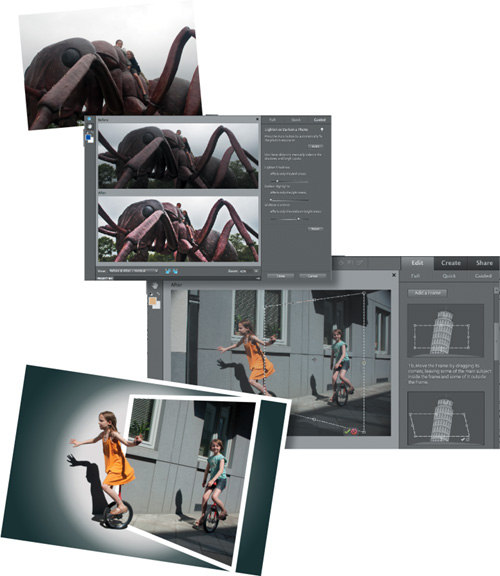
Explore the many powerful and versatile tools and options that make it easy to get more from your photos in Photoshop Elements—even if you’re a beginner. Start with a few of the easy-to-use, one-step image correction features, and then experiment with a few more advanced techniques, such as layering preset adjustments with the Smart Brush.
Before you start working on the exercises in this lesson, make sure that you have installed the software on your computer from the application CD (see the Photoshop Elements 9 documentation) and that you have correctly copied the Lessons folder from the CD in the back of this book onto your computer’s hard disk. (See “Copying the Classroom in a Book files” on page 2.)
To start, you’ll import the sample images for this lesson to the CIB Catalog that you created at the beginning of Lesson 4:
Start Photoshop Elements and click Organize in the Welcome Screen.
The name of the active catalog is always shown in the lower left corner of the Organizer window. If your CIB Catalog is already loaded, you can skip step to step 4. If another catalog is currently loaded, continue with step 3.
Choose File > Catalog. In the Catalog Manager dialog box, click to select your CIB Catalog in the Catalogs list, and then click Open. If you don’t see the CIB Catalog listed, review “Creating a new catalog” at the beginning of Lesson 4.
Choose File > Get Photos And Video > From Files And Folders. In the Get Photos And Videos From Files And Folders dialog box, locate and open your Lessons folder. Select the Lesson06 folder, disable any automatic processing option that is currently active, and then click Get Media.
In the Import Attached Keyword Tags dialog box, click Select All, and then click OK. Click OK to close any other alert dialog box.
In the Media Browser, you can see thumbnails of the images you’ve just imported to your CIB catalog. In the Keyword Tags panel, the newly added Lesson 06 tag has been listed under Imported Keyword Tags.
Some of the easiest and most convenient ways to quickly fix many of the most common image problems are at your fingertips, without even leaving the Organizer.
In the Keyword Tags panel, click the empty Find box beside the Lesson 06 tag to ensure that the photos for the following exercises are isolated in the Media Browser. Make sure that the Details and Show File Names options are activated in the View menu. In the Media Browser, select the image DSC_2076.jpg.
Click the Fix tab at the top of the Task pane. On the Fix tab, click the Auto Smart Fix button. The edited file is grouped with the original in a Version Set. In the media browser, the edited version appears as the top image in the collapsed (or closed) Version Set. Click the arrow at the right of the image frame to expand the Version Set.
When you edit a photo in the Organizer, a Version Set is created automatically. If you want to preserve your original image and group versions modified in the Editor, rather than the Organizer, you’ll need to choose File > Save As, and then activate the options Include In Organizer and Save In Version Set With Original.
In the expanded Version Set, select the image on the right—the original photo, DSC_2076.jpg, in its un-edited state.
On the Fix tab, click the Auto Color button. The newly edited version is added to the Version Set. In the Media browser the new version appears at the left of the expanded Version Set; if the set was collapsed, this would be the top image.

Select the original, un-edited image again and repeat the process for the Auto Levels button, and again for the Auto Contrast button. You should now have a Version Set grouping five images.
Double-click the original version of the image to see it enlarged in the Media Browser’s single image view. Use the left arrow key on your keyboard to compare the un-edited photo with the results of the four single-click adjustments you applied in steps 2–5.
Double-click the image in the enlarged single image view to return the Media Browser to the thumbnail view. Ctrl-click / Command-click to select all four edited versions of the image; then, right-click / Control-click any of the selected thumbnails and choose Delete Selected Items From catalog.

In the Confirm Deletion From Catalog dialog box, click to activate the option Also Delete Selected Item(s) From The Hard Disk; then, click OK. Click the Organize tab above the Task pane.
Full Screen mode in the Elements Organizer not only offers a fun way to view your images as an instant slideshow, but also provides access to the same automatic editing commands you’ll find on the Fix tab. The controls in the Full Screen mode Quick Edit panel enable you to make substantial improvements to an image with just a click or two and assess the results at a conveniently high zoom level.
In the Media Browser, select the image DSC_3583.jpg. Click the View, Edit, Organize In Full Screen button (
 ) above the Media Browser, or click the Display button (
) above the Media Browser, or click the Display button ( ) at the upper right of the Organizer window and choose View, Edit, Organize In Full Screen from the menu.
) at the upper right of the Organizer window and choose View, Edit, Organize In Full Screen from the menu.Move the pointer over the full screen image to see the control bar at the bottom of the screen. If necessary, click the Pause button, and then click the Toggle Film Strip button at the left of the control bar, or press Ctrl+F on your keyboard, so that you can see a strip of thumbnails at the right of the screen as shown below.
Move the pointer to the upper left edge of the screen to show the Quick Edit panel; then, click to deactivate the Auto Hide button at the top of the vertical title bar of the Quick Edit panel so that the panel remains open while you work.

You can also access the Quick Edit panel by clicking the Toggle Quick Edit Panel button—right beside the Toggle Film Strip button in the control bar.
In the Quick Edit panel, hold the pointer over each button in turn to see a tooltip describing the effect it will have on the photo. Click the Auto Levels button, and then click the Auto Red Eye Fix button. Click OK to accept the creation of a new Version Set.
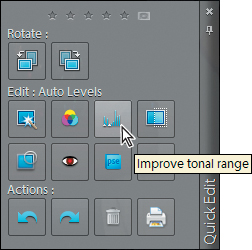
Click to re-activate the Quick Edit panel’s Auto Hide button, and then move the pointer away; the Quick Edit panel closes after a second or so.
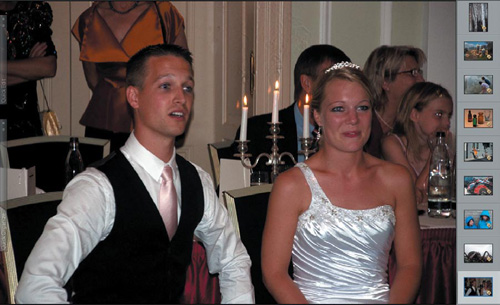
You’ve improved this photo dramatically with just two clicks—and without leaving the organizer; you can click the play button in the Full Screen view control bar to restart the slideshow, and go right back to reviewing and organizing your images.
Press the Esc key on your keyboard or click the Close button (x) in the control bar to exit Full Screen mode and return to the Media Browser.
Expand the Version Set that you just created; then, right-click / Command-click the edited version of the image and choose Delete From Catalog from the menu. In the Confirm Deletion From Catalog dialog box, activate the Also Delete Selected Item(s) From The Hard Disk option; then, click OK.
You’ll be using a different technique to fix this photo later in the lesson.
For some photos, applying one-click fixes in the Organizer will be enough, but when you want more control—and access to the full power of Photoshop Elements editing, adjustment and correction tools—you’ll work in the Editor. In the rest of this lesson you’ll improve images in each of the three Editor modes: Full Edit, Quick Edit, and Guided Edit. Before you continue with the exercises, you can take a few minutes to familiarize yourself with switching between the three working modes, and to get an overview of the different editing workspaces.
Select two or three images in the Media Browser; then, click the small arrow on the Fix tab at the top of the Task Pane and choose Full Photo Edit from the menu.
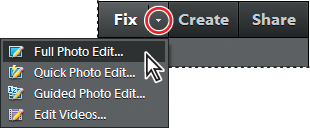
In Full Edit mode, choose Window > Reset Panels or click the Reset Panels button (
 ) at the top of the workspace. By default, the Effects, Content, and Layers panels are open in the Panel Bin.
) at the top of the workspace. By default, the Effects, Content, and Layers panels are open in the Panel Bin.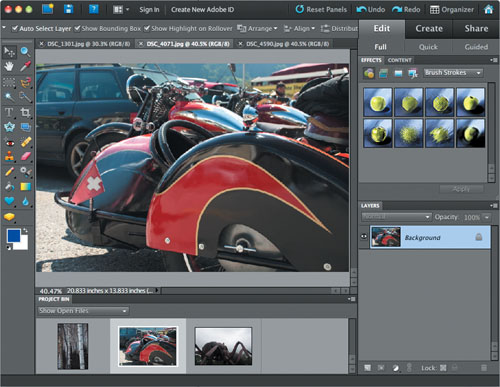
The Full Edit mode is Photoshop Elements’ most powerful and versatile image editing environment, with commands for correcting exposure and color and tools for making precise selections and fixing image imperfections. The Full Edit tool bar even includes painting and text editing tools. You can arrange the flexible Full Edit workspace to suit the way you prefer to work by floating, hiding, and showing panels.
The Project Bin below the Edit pane displays thumbnails of the photos you opened for editing. In the Project Bin menu, you can also choose to display files currently selected in the Organizer, or show the contents of any of your albums.
Click a thumbnail in the Project Bin to select an image. Double-click a thumbnail to bring that image to the front. At the top of the Edit pane, the name tab of the foremost image is highlighted. Click another name tab to bring that photo to the front.
Drag any panel out of the Panel Bin by its header bar, to float the panel wherever you like in the workspace. Click the Close button (x) in the header bar of the floating panel to close it.
Choose the name of the panel you just closed from the Window menu. Checkmarks are displayed beside the names of panels that are currently open. Drag the re-opened floating panel back into the Panel Bin. You can dock the panel as part of a tabbed panel group by dragging it to the header of another panel, or drop it between the frames of other panels. Whichever way you choose, release the mouse button when a blue line appears to highlight the targeted position.
Tip
You can review the techniques for working with panels in “Using panels and the Panel Bin” on page 21.
Experiment with dragging the Toolbox and Project Bin to float over the Edit pane, and then re-docking them. When you’re done exploring, click the Reset Panels button (
 ), and then click the Quick Edit tab above the Panel Bin.
), and then click the Quick Edit tab above the Panel Bin.
Each Edit mode offers a different set of tools, controls and views. In Quick Edit mode, the Panel Bin is occupied by the Quick Fix panel, with separate panes for Smart Fix, Lighting, Color, Balance, and Sharpness controls.
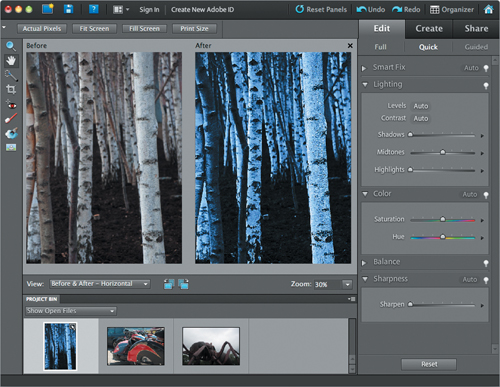
Tip
In Quick Edit mode you cannot add, remove or float panels. To clear extra screen space, collapse the Project Bin by double-clicking its header bar and hide the Toolbox by un-checking Tools in the Window menu.
Choose a Before & After view option from the View menu below the Edit pane.
Collapse and expand any of the control panes in the Quick Fix panel by clicking the triangle at the left of the header of that pane.
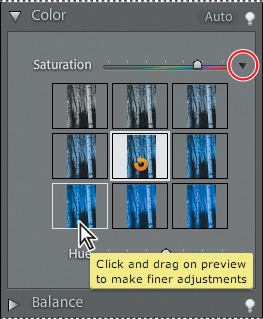
Click the small black arrow to the right of any control slider. A grid of preview thumbnails is displayed, showing the full range of variation possible with that control. A white frame highlights the current setting. Move the pointer slowly over each preview thumbnail in the grid to see that level of adjustment applied temporarily to your image in the After view.
Click the Reset button at the bottom of the Quick Fix panel to discard any changes you’ve made. Click the Reset Panels button (
 ), and then click the Guided Edit tab at the top of the Panel Bin.
), and then click the Guided Edit tab at the top of the Panel Bin.
In Guided Edit mode the Panel Bin displays the Guided Edit panel, with grouped listings for a wide range of common—and not-so-common—image editing tasks.
Tip
If you’re new to digital imaging, the Guided Edit mode enables you to learn as you work, making it a great starting point for fixing and modifying your photos.
Click any listing to find simple step-by-step instructions and any tools or controls that you’ll need for that task. Try several of the guided procedures.
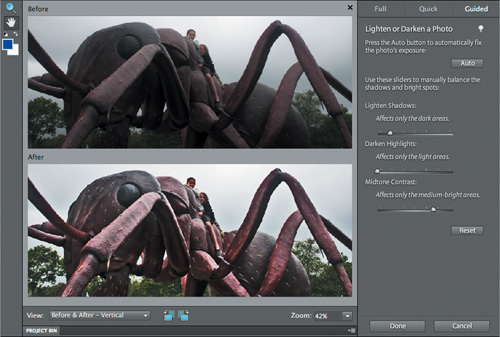
When you’re done experimenting, choose File > Close All. Click Don’t Save to discard any changes you made, keeping the images intact for the next exercise.
Many of the photographs used for the lessons in this book were chosen to illustrate common image faults—the kind of challenges that people face every day as they try to make the most of their photographs. Artificial light sources, unusual shooting conditions, and incorrect camera exposure settings can all result in tonal imbalances and unwelcome color casts in an image. In the following exercises we’ll look at some quick and easy ways to correct such problems in Photoshop Elements.
You can make adjustments using the simple controls in Quick Edit mode, let the Guided Edit mode step you through a wide range of editing tasks, perform sophisticated edits selectively in Full Edit mode—or even have Photoshop Elements batch-process your photos, applying your choice of automatic corrections.
Photoshop Elements enables you to fix multiple photographs with a single command by processing them as a batch. In this exercise, you’ll apply automatic fixes to all the image files used in this lesson. You’ll save the auto-adjusted files as copies so that at the end of each project you can compare these automatic results to the edits you’ve made to the original files using various other techniques.
Make sure you’re in Full Edit mode; then choose File > Process Multiple Files.
From the Process Files From menu in the Process Multiple Files dialog box, choose Folder; then, set the source and destination folders as follows:
Under Source, click the Browse button. Find and select the Lesson06 folder in your Lessons folder. Click OK / Choose to close the Browse For Folder / Choose A Folder For Processing Multiple Files dialog box.
Under Destination, click Browse; then, find and select the My CIB Work folder that you created at the start of the book. Click OK / Choose to close the Browse For Folder / Choose A Destination Folder dialog box.
Under Quick Fix on the right side of the dialog box, click the checkboxes to activate all four options: Auto Levels, Auto Contrast, Auto Color, and Sharpen.

Under File Naming, activate Rename Files. Choose Document Name from the menu on the left and type _Autofix in the second field. This adds the appendix “_Autofix” to the existing document name as the files are saved.
Review the settings in the dialog box. Make sure that the Resize Images and Convert Files options are disabled, and then click OK.
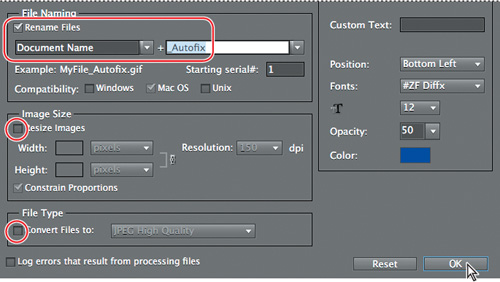
Note
For Windows users; if an error message appears after you click OK in the Process Multiple Files dialog box warning that some files couldn’t be processed, you can ignore it. This error is often caused by a hidden file that is not an image, so it has no effect on the success of your project.
Photoshop Elements goes to work, automatically opening and closing image windows. All you need to do is sit back and wait for the process to finish. The newly copied files are automatically tagged with the same keywords as the source files.
For most files modified in the Editor, the Include In Organizer option is activated in the Save, Save As, and Save Optimized As dialog boxes by default. However, when you batch-edit files with the Process Multiple Files feature, this option isn’t part of the process—you must add the edited files to the Organizer manually.
Switch to the Organizer; then, choose File > Get Photos And Videos > From Files And Folders.
In the Get Photos From Files And Folders dialog box, locate and open your My CIB Work folder, and then Ctrl-click / Command-click or marquee-select all eight files with the suffix “_Autofix.”
Activate Automatically Fix Red Eyes and disable any other automatic processing option that is currently active; then, click Get Media. If the Auto Red Eye Fix Complete dialog box appears, click OK to accept the creation of a Version Set.
In the Import Attached Keyword Tags dialog box, click Select All, and then click OK. Click OK to dismiss any other dialog box.
The files are imported to your CIB Catalog and the Organizer displays thumbnails of the newly added images in the Media Browser.
If you’re a newcomer to digital image editing, the Guided Edit mode is a great place to start. By letting Photoshop Elements step you through the process of improving your photos you’ll not only achieve impressive results quickly, but also learn a lot about image problems and solutions as you work.
Note
As you try more advanced tasks in Photoshop Elements 9, you may find that you need more information to solve any problems you encounter. For help with some common problems you might have while working through the lessons in this book, see the section “Why won’t Photoshop Elements do what I tell it to do?” in Lesson 7.
Click any of the wide range of editing tasks listed in the Guided Edit panel and Guided Edit will provide easy-to-follow steps and instructions, conveniently presented alongside any tools and controls you’ll need for that procedure.
Even more experienced users will enjoy the ease and simplicity of performing editing tasks in Guided Edit mode—and may just pick up some new tricks on the way!
One of the images in the Lesson06 folder, a photo featuring some old perfume bottles, has an obvious color cast as a result of inadequate artificial lighting. In this exercise, you’ll correct this common image problem in Guided Edit mode.
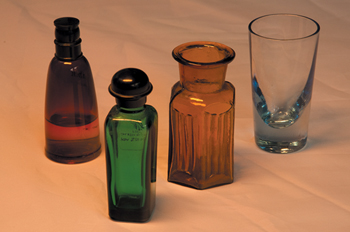
If you’re not already in the Organizer, switch to it now by clicking the Organizer button (
 ) at the top right of the Editor workspace.
) at the top right of the Editor workspace.In the Keyword Tags panel, click the Find box beside the Lesson 06 tag to find and isolate all the Lesson 6 images. The Image Browser should now display the eight original photos from the Lesson06 folder, eight automatically edited copies from your My CIB Work folder, and a single automatic red eye fix grouped in a version set with its _Autofix original.
This last image is the only file shown in the Image Browser that is not tagged with the Lesson 06 keyword. Drag the Lesson 06 tag to the un-tagged image, and then collapse the Version Set.
Select the original photo of the perfume bottles, DSC_2474.jpg, making sure not to confuse the original file with the _Autofix copy.
Click the small arrow on the Fix tab at the top of the Task Pane and choose Guided Photo Edit from the menu.

Unwelcome color casts are a very common problem in digital images. Fortunately, in Guided Edit you can correct the color in just one step!
If necessary, click the triangle beside the Color Correction header in the Guided Edit panel so that you can see the nested options in that group, and then click Remove A Color Cast.

From the View menu at the left of the bar below the Edit pane, choose the Before & After-Horizontal view.
Read the instructions under Correct Color Cast. Then, using the Color Cast Eyedropper tool, click the bright area in the lower left corner of the Before image to remove the color cast. Notice the change in the After image.
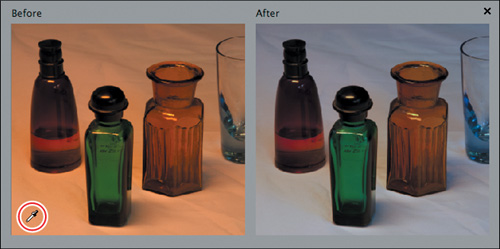
If you’re not satisfied with the result, click the Reset button in the Guided Edit panel, and then click a different point in the Before image with the Color Cast Eyedropper tool. Although the color cast is removed, the image is still quite dull; you’ll fix that in the next exercise
When you’re satisfied with what you see in the After image, click Done.
As is often the case with poorly exposed photos, this image has more than just one problem. After the color cast has been removed, it’s obvious that the image would benefit from some lighting adjustments.
If necessary, click the triangle beside the Lighting And Exposure header in the Guided Edit panel so that you can see the options in that group, and then click Lighten Or Darken.
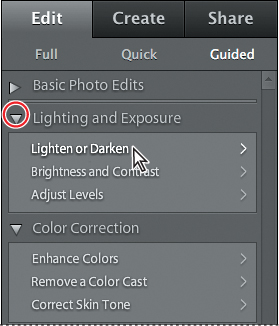
In the Guided Edit panel’s Lighten Or Darken A Photo controls, click the Auto button. Notice the substantial improvement in the appearance of the image.
Use the Lighten Shadows, Darken Highlights, and Midtone Contrast sliders to fine-tune the lighting for this image. We set a value of 50 for Lighten Shadows, left the Darken Highlights slider at 0, and set Midtone Contrast to a value of 70. Your choices may differ, depending on the results of your color correction in the previous exercise and your preferences for the look of the final image.

When you’re satisfied with the results of your lighting adjustment as displayed in the After image, click Done.
In the Guided Edit panel, click Sharpen Photo in the Basic Photo Edits group. Click the Auto button near the top of the Sharpen Photo panel. Use the slider to fine-tune the sharpening to your liking, and then click Done.
Choose File > Save As. In the Save As dialog box, navigate to and open your My CIB Work folder. Leaving the JPEG file format selected, name the file DSC_2474_Guided. Activate Include In The Elements Organizer and disable Save In Version Set With Original.
Click Save. In the JPEG Options dialog box, choose High from the Quality menu, and then click OK.
Choose File > Close, and then switch back to the Organizer.
With just a few clicks you’ve improved the appearance of the photo dramatically. You don’t need to have prior experience using an image editor to get good results in Guided Edit mode.
Try the Guided Activities—Touch Up Scratches And Blemishes, Guide For Editing A Photo, and Fix Keystone Distortion—with some of your own photos. Each of these procedures will step you through several image editing tasks in the order recommended to achieve professional-looking results.
The Guided Edit panel includes a lot more than just correction, adjustment, and retouching tasks. The Photomerge pane includes procedures for combining multiple photos (you’ll learn about those in Lesson 11), and the Photographic Effects and Fun Edits panes let you experiment with a range of striking and unusual creative treatments for your photos.
If necessary, click the Find box beside the Lesson 06 tag In the Keyword Tags panel, to find and isolate all the Lesson 6 images. Select the original image of the girls on unicycles, making sure not to confuse it with the _Autofix copy.

Click the small arrow on the Fix tab at the top of the Task Pane and choose Guided Photo Edit from the menu.
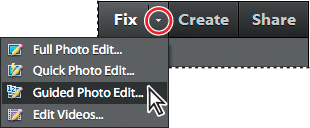
In the Guided Edit panel, expand the Fun Edits pane and click Out Of Bounds.
Hide the Project Bin; then click the Fit Screen button above the Edit pane.
Follow the instructions in the Guided Edit panel. Start by clicking Add A Frame, and then let Guided Edit step you through the process of setting up the frame as you see in the illustration below. When you’re happy with the frame, click the green Commit button (
 ) at the lower right corner.
) at the lower right corner.
Continue with the guided steps until you can replicate something similar to what you see in the illustration below; then, click Done. Don’t be discouraged if you need a few attempts—with a little practice you’ll get great results.

Tip
Remember these pointers when you’re using the Quick Selection tool in step 3 of this guided edit:
Use Ctrl / Command+[ to decrease the brush size, Ctrl / Command+] to increase it.
Hold down the Alt / Option key to subtract from the selection.
Difficult selections can be made much easier using the Auto-Enhance and Refine Edge options in the tool options bar above the Edit pane.
Choose File > Save As. Name the file, check Include In The Elements Organizer, disable Save In Version Set With Original, and save to your My CIB Work folder.
Experiment with the other guided edits in the Photographic Effects and Fun Edits groups. Apply these effects as they come, use them as inspiration, or treat them as a starting point for further editing. Illustrated here are examples of the Reflection, Old Fashioned Photo, Pop Art, Lomo Camera Effect, and Line Drawing edits.
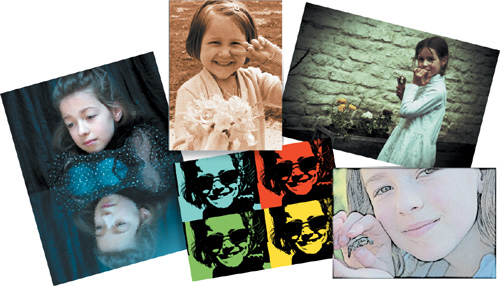
In the exercise to follow, you’ll move on to the next level of editing: working in the Quick Edit mode, where Photoshop Elements conveniently presents many of the basic photo fixing tools so that they’re all at your fingertips in the Quick Fix panel.
If you find that one control doesn’t work for your image, click the Reset button and try another. Whether or not you’ve used the Quick Fix panel before, the intuitive slider controls make adjusting your image easy.
When you apply a combination of automatic fixes to a set of images using the Process Multiple Files feature, the process happens too fast for you to see the changes made to each image at each stage of processing.
In this exercise, you’ll apply some of the same automatic fix options one at a time. This will enable you to see how each editing step affects an image and give you the opportunity to fine-tune the default settings for the best results.
Once again, you can use the Lesson 06 Keyword Tags to find the sample image you want, and then open it in Quick Edit mode.
If you are already in the Organizer with the Lesson 06 files still isolated in the Media Browser from the last exercise, skip to step 3.
Switch to the Organizer and click the Find box beside the Lesson 06 tag in the Keyword Tags panel.
Select the original photo of the perfume bottles, DSC_2474.jpg, making sure not to confuse the original file with the edited copies.
Click the small arrow on the Fix tab at the top of the Task Pane and choose Quick Photo Edit. Wait while the image opens in the Editor.
In the Quick Edit workspace the Quick Fix panel at the right contains five adjustment panes—Smart Fix, Lighting, Color, Balance, and Sharpness. The Smart Fix feature is actually a combination of several adjustments applied at once; it corrects overall color balance and improves shadow and highlight detail in your image. As with the other editing options in Quick Edit mode, you can either click the Auto button to apply the correction automatically or use the slider controls to fine-tune the adjustment. You can also combine these methods, as you will in this exercise.
Choose Before & After - Horizontal from the View menu in the bar below the Edit pane. Alternatively, if you prefer the before and after images one above the other rather than side-by-side, choose the Before & After - Vertical view.
In the Quick Fix panel, click the Smart Fix Auto button in the Smart Fix pane. Notice the immediate effect on the image.
Now, move the Smart Fix Amount slider to change the color balance and the highlight and shadow settings for your image. Experiment to find the setting you prefer. We set the Smart Fix Amount to a value of 70.
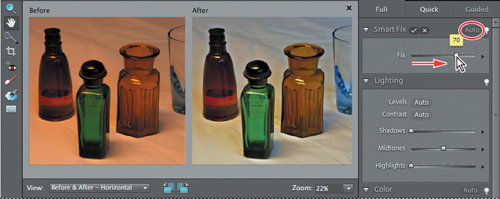
Click the Commit button (
 ) in the header of the Smart Fix pane to commit the changes.
) in the header of the Smart Fix pane to commit the changes.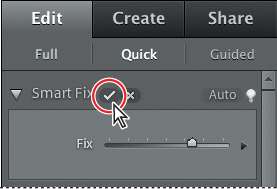
Remember that whenever you change a setting in the Quick Fix panel, you need to click the Commit or Cancel button in the header of the relevant task pane to accept or discard the changes.
Four more automatic Quick Fix adjustments are available in the Lighting, Color, and Sharpness panes. (There is no Auto Balance adjustment.)

In the Lighting pane, click the Auto Levels and Auto Contrast buttons.
You may or may not see a significant shift in the tonal balance of this image, depending on the adjustment you made with the Smart Fix edit.
Click the Auto Color and Auto Sharpen buttons, noting the effects of each of these adjustments in the After view.
In the Quick Fix Color pane, click the small black arrow to the right of the Saturation slider.
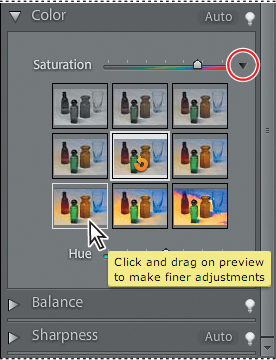
A grid of nine preview thumbnails is displayed, showing the full range of variation possible with the Saturation slider. A white frame highlights the central thumbnail—the preview that represents the current saturation setting.
Move the pointer slowly over each preview thumbnail in the grid to see that level of saturation applied temporarily to your image.
Clicking any of the thumbnails will apply the respective level of adjustment; click a thumbnail and drag left or right to fine-tune the adjustment. The Quick Fix previews not only provide a intuitive editing interface but also make a great way to learn about the effects of the various adjustment controls as you work with them.
Experiment with the slider controls and Quick Fix preview grids in each pane of the Quick Fix panel. When you’re satisfied with an adjustment, click the Commit button (
 ) in the title bar of that pane to accept the changes.
) in the title bar of that pane to accept the changes.If you wish to undo your modifications and start again with the original version of the image, click the Reset button at the bottom of the Quick Fix panel.
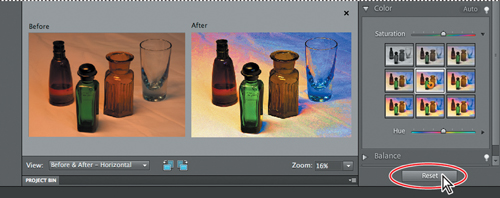
When you’ve achieved the results you want, choose File > Save As. In the Save As dialog box, navigate to and open your My CIB Work folder, rename the file DSC_2474_Quick and select the JPEG format. Activate Include In The Organizer and disable Save In Version Set With Original.
Click Save. When the JPEG Options dialog box appears, choose High from the Quality menu, and then click OK. Choose File > Close.
The Whiten Teeth, Blue Sky, and Black And White-High Contrast tools in the Quick Fix mode toolbox are all variants of the Smart Brush tool in Full Edit mode.
The Smart Brush is both a selection tool and an image adjustment tool—it creates a selection based on similarities in color and texture, through which your choice of editing preset is applied.
While the selection is active, you can add to or subtract from it, without needing to re-applying the adjustment. Each Smart Brush edit is made on its own adjustment layer, so it doesn’t permanently alter the original photo. The Smart Brush edit remains active on its adjustment layer; you can return at any time to edit the selection area or change the way the adjustment is being applied—or even to delete the adjustment layer entirely—without degrading your original image.
If you’re not already in the Organizer with the Lesson 6 files isolated in the Media Browser, switch to the Organizer now and click the Find box beside the Lesson 06 tag In the Keyword Tags panel.
In the Media Browser, select the image DSC_1830.jpg, a photo of a very unusual building—making sure not to confuse the original file with the _Autofix copy.
Click the small arrow on the Fix tab at the top of the Task Pane and choose Full Photo Edit from the menu.
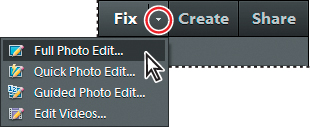
In the final two exercises for this lesson you’ll use the Smart Brush to liven up defined areas of a photograph selectively.
In Full Edit mode, click the Reset Panels button (
 ) at the top of the workspace. Hide the grouped Effects and Content panels, and the Project Bin, by double-clicking their header bars, and then choose View > Fit On Screen.
) at the top of the workspace. Hide the grouped Effects and Content panels, and the Project Bin, by double-clicking their header bars, and then choose View > Fit On Screen.Select the Smart Brush (
 ) from the toolbox; then, drag the Smart Brush adjustment presets picker from the tool options bar to a position where it won’t obstruct your view of the photo while you work.
) from the toolbox; then, drag the Smart Brush adjustment presets picker from the tool options bar to a position where it won’t obstruct your view of the photo while you work.
Click the categories menu at the top of the floating Smart Brush presets picker and choose the category Nature. Scroll down through the options in the Nature category and select the Greenery preset.
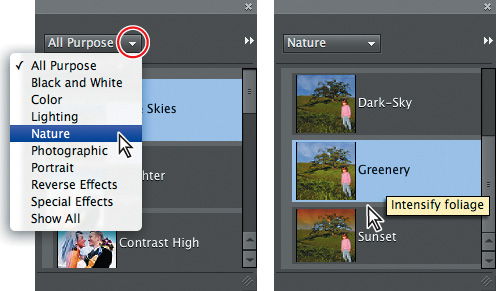
Click the Close button (x) in the header of the Smart Brush presets picker. In the tool options bar, open the Brush Picker and set the brush diameter to 20 px (pixels). To close the Brush Picker, click elsewhere in the tool options bar, or use the Esc key on your keyboard. Drag half-way across the dull-looking lawn in the foreground as shown in the illustration below; then, release the mouse button.
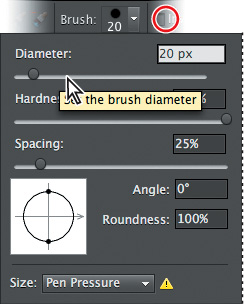
Don’t be concerned if your selection expands to include the road and shrubs. If you wish to subtract from the selection, hold down the Alt / Option key as you paint.

The Greenery brush has not made a very effective difference to the image. Let’s try some methods for modifying the adjustment to boost the effect.
The adjustment you applied shows a “pin”—a colored marker that identifies a Smart Brush edit when the Smart Brush tool is active—at the point that you first clicked with the Smart Brush. Right-click / Control-click the pin and choose Change Adjustment Settings from the context menu.

The Adjustments panel opens in the Panel Bin. Experiment with the three sliders, noting the changes in the image. When you’re done experimenting, click the Reset button at the bottom of the Adjustments panel to return the settings to the defaults for the Greenery preset; you’ll be looking at another way to modify the effects of this Smart Brush adjustment yet.
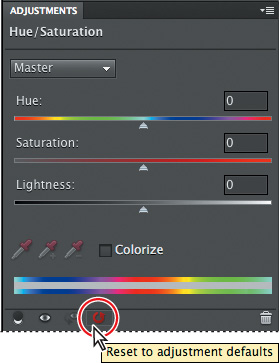
Collapse the Adjustments panel by double-clicking its header bar. If necessary, use the same method to expand the Layers panel.
In the Layers panel, the new adjustment layer, Greenery 1, is the active layer. Set the Opacity value for the new layer to 50% and the Blending Mode to Screen.
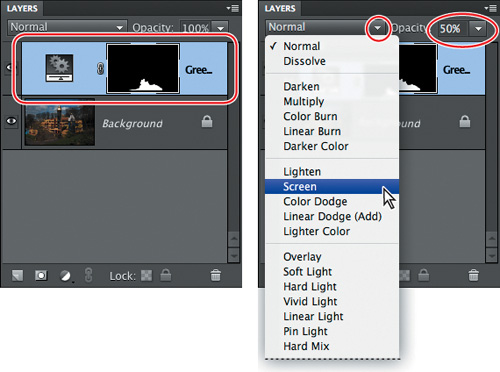
For this particular photo, this setting is far more effective, intensifying the colors in the lawn area and giving the scene as a whole a much sunnier look.
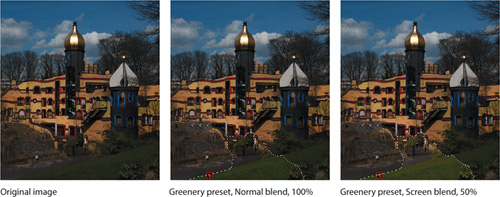
Paint over the rest of the lawn with the modified Greenery adjustment settings. Leave the road selected if you wish, but try to exclude the walls and towers. Hold down the Alt / Option key as you paint to subtract from the selection. Press the left bracket key ([) to decrease the brush size, and the right bracket (]) to increase it. While you’re fine-tuning the selection, use a small brush and slow, short strokes. When you’re satisfied, choose Select > Deselect Layers.
You can use the Smart Brush on the same area as many times as you wish. If you re-apply the same adjustment preset the effects are usually cumulative, though the results will depend on the layer blending mode for that preset. You can also apply different Smart Brush presets to the same image area, combining their effects.
With the Smart Brush tool still selected in the toolbox, click the thumbnail in the tool options bar to open the Smart Brush adjustment presets picker once more. Drag the presets picker to a convenient position clear of the image.
In the presets picker, choose the Nature category; then select the Blue Skies preset. Drag across the sky from the upper left corner. It will be impossible to deal with the bare trees other than to deliberately include them in the selection. In the Layers panel, change the Blending mode for the new layer Blue Skies 1 from the preset Color Burn to Overlay and decrease the Opacity value from 75% to 50%. Choose Select > Deselect Layers to deactivate the new adjustment.
In the presets picker, select Cloud Contrast; then drag left across the sky from the upper right, just clear of the tree branches. There are now three Smart Brush pins on the image. Change the Blending mode for the new layer Cloud Contrast 1 from Normal to Soft Light and reduce the Opacity value to 40%. Choose Select > Deselect Layers to make the new adjustment inactive.
Choose the Dark Sky preset and drag across the sky from the lower left, just above the trees. Change the layer Opacity to 100% and the Blending mode to Luminosity. In the Layers panel, select the layer Greenery 1. You can see that there are now three Smart Brush pins on the sky, and three corresponding new layers in the Layers panel. Use the eye icon at the left of each layer to toggle its visibility so you can compare the different treatments you applied to the sky.
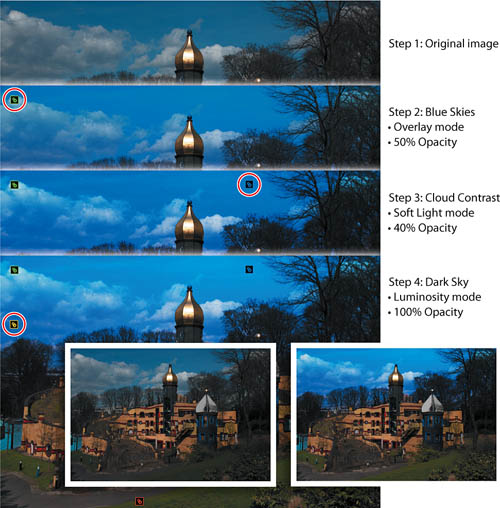
Chose File > Save As. Name the file DSC_1830_SmartBrush and save it to your My CIB Work folder in Photoshop (.PSD, .PDD) format with Layers activated. Activate the Include In The Organizer option and disable Save In Version Set With Original.
Congratulations, you’ve completed this lesson. You’ve gained a lot of experience with all three Edit modes and discovered many of the fast and easy options for improving your photos. Take a few moments now to review what you’ve learned.
